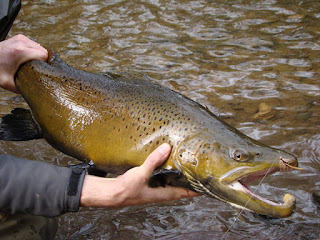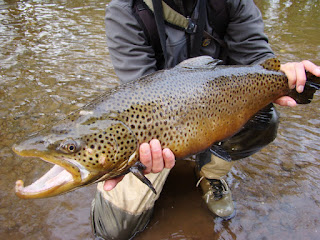
I know the fall tributary season has been going on for some time now, especially at the Salmon River. And our WNY tribs are starting to see some fish too, but that has been a more recent development. So before our tributaries really start to heat up, I want to take some time to share some thoughts on making the most out of this early part of the season. And in my experience, there is a difference between early season salmon and trout fishing on the tribs as opposed to mid and late season salmon and trout fishing on the tribs.
First of all let’s break down the season. For those of you who fish the Salmon River, you already have figured out that it is quite a bit different than most of the other rivers that flow into lake Ontario, and therefore gets the best early run of fish, sometimes as early as late August.  And for that reason, it is the exception, not the rule. For most of the other area tribs, they will see fish a bit later, usually early to mid September, as do most of our bigger WNY tribs. When and why the fish start to run is a debate that has been going on ever since I can remember, but in the end, it is up to the fish. So in this first installment I will go over some of the lessons I have learned over the years.
And for that reason, it is the exception, not the rule. For most of the other area tribs, they will see fish a bit later, usually early to mid September, as do most of our bigger WNY tribs. When and why the fish start to run is a debate that has been going on ever since I can remember, but in the end, it is up to the fish. So in this first installment I will go over some of the lessons I have learned over the years.
This early part of the fall can be a whole lot of fun. It’s the time when you will see your first salmon or large trout, and even though you may only see that one fish, it’s enough to send you over the edge! The weather is usually still quite warm, and you can often get away with wearing a t-shirt. You also tend to have the last bit of the summer time “low water” conditions, and if conditions warrant it – your first crack at catching that first tributary trout or salmon. But the icing on the cake is the amount of water you will find all to yourself. It usually takes a good weekend or so of multiple confirmed catch reports, and photos, to put the crowds on the stream. So until then, enjoy your privacy!
Because of these reasons and more, I hav e found that fishing to these early run fish is way different than those fish that have been in the system longer and those that enter toward the middle part of the season. And here are a few tips to help get you that first trout or salmon of the early season.
e found that fishing to these early run fish is way different than those fish that have been in the system longer and those that enter toward the middle part of the season. And here are a few tips to help get you that first trout or salmon of the early season.
1 – Fish the early part of the day and again in the evening. The early season fish that enter often do so in smaller groups until they decide to run in big numbers (figuring that out is a crap shoot.) The fish will feel more at home in low light conditions than when the sun is beating down on them in a small stream, and low water conditions. And the smaller the stream or river is, the smaller the group of fish will be that enter the system.
2 – Keep back from the fish if you can. When fish are just entering a system, they are often very wary of every movement and sound. And fishing smaller tribs will only amplify this effect. The shallow water of a stream or river is a whole new world for fish that are coming from a deep lake - This will change later in the season as fish numbers build, water temperatures lower, and salmon start to spawn – So it pays to be extra careful in the early part of the fall tributary  season. It’s also a good idea to stay back from the fish when fishing in the low light periods of the day because the fish will often hold right near the bank, and many times you may not even need to get into the water.
season. It’s also a good idea to stay back from the fish when fishing in the low light periods of the day because the fish will often hold right near the bank, and many times you may not even need to get into the water.
3 – Don’t fish egg patterns…yet! This sounds easy enough, but I have seen tons of early season anglers come armed with plenty of egg patterns to throw at fish when the salmon haven’t even started to spawn. It is better to stock your fly boxes with fly patterns that resemble what the fish will see, such as large minnows, shiners, sculpin and other aquatic insects such as nymphs (stonefly and mayfly) along with caddis larvae and pupae, not to mention a few dry flies! So carry woolly buggers, comets, rabbit strip streamers, and any other favorite pattern in both naturally subdued colors such as brown, black, olive along with bright attractor patterns such as white, chartreuse, pink, orange, etc., in sizes #12-#2. I would also carry plenty of stonefly patterns, hare’s ears, caddis larvae and pupae, along with wet flies in similar colors in sizes #6-#14. All these flies can be either dead drifted, swung, or both! The morning and evening will be the best time to swing the big bright stuff on heavier tippet, while the late morning through the day light hours into late afternoon, may be the best time to lighten up the tippet and go small with a more natural colored fly like a nymph.
4 – Pick your spot well! Depending on the water you fish, salmon and trout will be in the greatest numbers in either the lower part of the system or at the top. For instance – The Salmon River has already received some good runs of fish so far. And when that run comes in, the lower end will fish really well, as the fish are still concentrated together. Once they get into the middle part of the river they really start to spread out. And then as they finally reach the top end of the river their numbers once again build, as they can’t go any further. This also holds true for many of our WNY tail water tribs. Fish will enter the lower part together, spread out in mid river, and then congregate at a dam. Fish can still be found mid river in deeper holes and long pools, and it’s worth the effort to scout the head of these spots early in the year when fish are still on the move. Again – this will change as the season progresses and more and more fish fill the river and spawning starts to get under way.
5 – Trout vs. Salmon. Both fish can be very aggressive when they first come into a system, but the salmon will be on a mission to get to the spawning grounds, and the trout are there to follow the salmon to get a free meal when that time comes, and until the brown trout spawn starts in Late October and all of November. The point is their behavior can be very different at times! You may be able to pick up a few salmon while slowly swinging a wet fly deep at the head of a pool, and then while fishing a transition piece of water like a run or riffle section, pick up some fresh steel while dead drifting a stonefly pattern under an indicator. It pays to either carry two rods with two different rigs, or be ready to switch it up at any time. This of course doesn’t mean that you can’t catch trout while fishing for salmon or vice versa (I have done it many times), it just means that they are different fish and will often hold in different spots and behave differently, so it pays to be observant and willing to change when needed.
6 – New Perspectives & Expectations - Early fall fishing on the tribs can be at times long and fruitless, due to the fact that there aren’t as many fish in the system yet. So re-evaluate your expectations to fit the season. I know this sounds a bit crazy to do, but it can really make your day a whole lot better. When I was a younger less experienced angler, I would try and tell myself that I could still have those great days of hooking and landing fish early in the season that I enjoyed so much during the height of the run. And more often than not, I would come home very disappointed because of it. If only I could have had changed my perspective and expectations to meet the reality of the situation, it would have made for a much better experience. So instead of getting frustrated that you aren’t catching fish, even though you saw a photo of a few guys catching a few fish here and there, maybe you could try and work on a new technique or go explore some “off the beaten path” water you’ve always wanted to try. You never know….you may be surprised!
Next time I’ll go over what to look for during the middle of the season.
 t few weeks. I even had the opportunity to land a late run Coho salmon while swinging big streamers for post spawn brown trout. This was a great treat for me, as I haven't had the pleasure of Mr. Coho's company in some time.
t few weeks. I even had the opportunity to land a late run Coho salmon while swinging big streamers for post spawn brown trout. This was a great treat for me, as I haven't had the pleasure of Mr. Coho's company in some time. s it is about the process of catching fish with a fly. They all, like me, have spent many hours in search of fish with a fly rod in hand and have photographed, written, and blogged about it in their own way. A way that is artistic and inspiring. So please click on their names to view their work.
s it is about the process of catching fish with a fly. They all, like me, have spent many hours in search of fish with a fly rod in hand and have photographed, written, and blogged about it in their own way. A way that is artistic and inspiring. So please click on their names to view their work.


